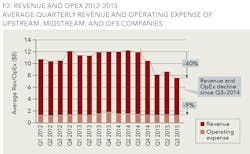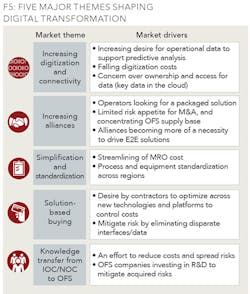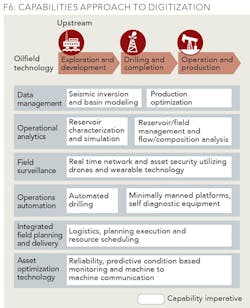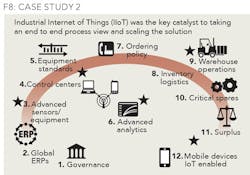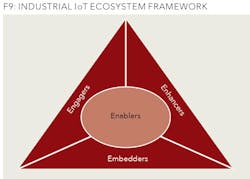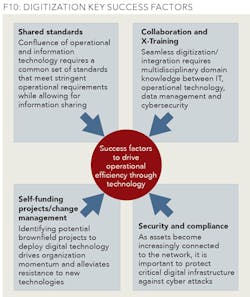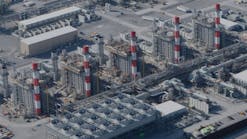THE CHANGING OIL AND GAS LANDSCAPE AFFORDS OPPORTUNITIES FOR IMPROVING OPERATIONAL EFFICIENCY
NATE CLARK, ABHISH ABRAHAM, AND AMIR ANVAR, STRATEGY&, HOUSTON
THE OIL AND GAS industry is facing intense pressure to improve operational efficiencies as lower oil prices continue to crimp margins. Additionally, capital expenditures for exploration have dropped 26% since 2014, which shifts the focus to maximizing production and throughput by "sweating" existing assets (Figure 1).
While the industry continues to swing between highs and lows, the operational nature of the business has remained relatively constant. Achieving a breakthrough on production performance demands a fresh perspective on field operations. Many oil and gas companies are responding by adjusting spend; however, broader opportunities exist to reduce overall spending. For instance, revenue has decreased 40% since 2014; however, operating expenses have declined by only 9% (Figure 2).
A critical tool that can accelerate operational efficiency and drive margins is the use of digital technology.
The term "digital" addresses the confluence of data, machines, and people that form the basis of the Internet of Things (IoT), which ultimately can create several opportunities:
- improve asset reliability,
- boost throughput, and
- optimize field recovery.
Until recently, market factors did not incentivize or create an existential crisis large enough to require full scale adoption/implementation. Digitization will facilitate expansive monitoring, integrated operations, remote configuration, and self-management, thus enabling more efficient field operations. While the current market conditions are challenging, such inflection points lead to significant innovation opportunities. Case in point is the adoption of cloud technology by the financial sector post the financial crisis (Figure 4).
While various digitization initiatives over the past decade have attempted to address prioritizing efficiency gains over simple production growth, these attempts have been marked by inconsistent implementation, heavy capital investments, and extended pay-back periods. Additionally, they face several internal operational barriers that have prevented energy companies from realizing full value.
A key challenge is that oil and gas companies have been very conservative in implementing smart field technology. Until recently, market factors did not incentivize or create an existential crisis large enough to require full-scale adoption/implementation. For instance, the automotive and aviation industries implemented several enterprise-wide digitization initiatives to increase efficiency and tackle costs when they faced upheavals during the many crises that have plagued them. Auto manufacturers are using 3D scanning to generate models of competitor vehicles to run simulation benchmarks against their own sensor-covered cars to enhance engineering and design.
The airline industry uses digitization widely to reduce operating costs, employing systems that enable real-time resource planning to drive greater utilization of their planes. For example, smart engines notify maintenance and operation centers of performance issues while an aircraft is still in the air and request that a replacement part be waiting upon landing.
Digitization involves physical devices communicating directly with each other - machine-to-machine - with little or no human intervention. To the oil and gas business, digital includes smart elements such as sensors, measuring devices, and actuators embedded in drills, wellheads, and all other production equipment exchanging data in real time. Such exchange enables expansive monitoring, integrated operations, remote configuration and optimization, and even self-management. Wireless networking connects these elements, and through use of purpose-built applications sends the combined and integrated data to servers for processing, storage, and analytics.
Millions of smart elements sending real-time data 24/7 results in huge data sets and data flow. A single drilling rig can generate one terabyte of data per day, bringing the total amount of data passing through an oil field to potentially one peta byte (1015 bytes) or more per day. In a control room, personnel see and interact with an accurate virtual representation of the field and all its components. Field data can be processed continuously in real time, with applications automating decision-making, performing predictive analyses, reacting to alarms, and monitoring and controlling production process - with or without human intervention.
THE UNREALIZED OPPORTUNITY FOR DIGITIZATION
Almost all major and independent oil and gas companies have an innovative digital initiative under way, some for more than a decade. Oil and gas CEOs stress the fact that maximizing the value of the digital investments they've made requires a clear vision of how digital technologies can help achieve competitive advantage. In our discussions with clients, a consensus emerged around five themes that will shape the digital transformation in oil and gas (Figure 5).
The downstream sector, frequently plagued by long periods of low margins, shifted from a top-line to a bottom-line mindset and embraced digitization earlier than its upstream counterparts. Plants and refineries are now some of the most automated facilities in any industry. Every piece of equipment is under constant surveillance, control loops adjust themselves, and whole process analytics and simulations enable operators to predict the effects of changes in the system.
Embedded smart sensors in vessels, tanks, compressors, and turbines send real-time data to control rooms, where a handful of experts monitor processes and provide diagnostics. Additional opportunities exist in connecting biometric data to improve operator safety and materials movement within facilities.
Much like their downstream brethren, midstream companies' portfolios of gathering systems, pipelines, and storage facilities leverage vast digital components and ecosystems. Advanced measurement devices such as electronic flow metering technology, data-intensive pipeline inspection gauges (PIGs), SCADA, and digital sensors are prevalent industry-wide. The opportunity for midstream companies lies within future use of drones to perform pipeline flyovers and the ability to distill massive amounts of data into vital information for safety, pipeline integrity, and asset management.
The opportunities are seemingly endless, but until this point only a few organizations have captured meaningful value from their digital investments.
In the upstream sector, companies vary greatly in terms of digitization. They span from sophisticated, unmanned, automated, robotic drilling platforms to fields where sensors and communications barely exist and operations are still paper based. Analytics are widely used in seismic data processing, beyond-bit drilling, and predictive maintenance, and sometimes through crowdsourcing of expertise.
Digital oilfield initiatives have combined intelligent, self-monitoring wells, reservoirs, and facilities embedded with smart sensors with integrated models run and managed by engineers/experts in collaboration centers; wearable technology brings the field closer to the office; field automation technologies have provided real-time work scheduling; near-ubiquitous asset tracking and condition monitoring occurs via wireless sensors over a network backbone; 3D scanning technology is used to create virtual asset representations for construction optimization, maintenance planning, operator training, and simulation.
A new fleet of drones and smart robots armed with video analytics and artificial intelligence is inspecting pipelines and flare stacks and going places unsafe for humans. A relatively new technology in upstream is flow composition analysis; extending this through full life-cycle digitization will enable the stream to be more accurately valued.
Ultimately, companies are looking for whole-asset management across the life cycle to maximize returns. Digitization initiatives have come a long way toward realizing efficiencies in pockets. The biggest obstacle preventing full-scale success and adoption of enterprise digitization is the time the initiatives take to reach full deployment. Other factors that contribute to these extended durations include the combination of fragmented implementation, often in silos, and the preference for buying COTS (commercial off-the-shelf) that may not align to company standards required for seamless information sharing.
Most oil and gas companies view IT or digital as activities peripheral to the core business. Siloed digitization does not provide the cross-functional, cross-asset insights needed to drive efficiency at the enterprise level. Companies should approach digitization as a way to build out capabilities by utilizing technology across key aspects of the value chain (Figure 6).
DIGITAL'S TIME TO DELIVER FOR OIL & GAS
Industries and organizations thriving in the digital era have shown that differentiation from competition is achieved through an ecosystem that enables data-driven insights. This has shifted the perspective in the oil and gas industry to view digitization as a critical component of core business.
Digitization has changed with time and has provided incremental value over what was already available on the market. This technology has served as a platform to enable future developers to create value-add applications. In upstream, for example, the Digital Oilfield concept and associated initiatives have been around for 10 to 15 years. So far, we have only laid the foundations for the upstream platform that will enable the next generation of value-add developments.
While there have been some additional steps taken, such as introducing Internet of Things (IoT) initiatives, we have not made all of the operating model changes (people, process, and technology) needed to maximize value from having data and information. The industry is in need of an end-to-end digitization platform, or ecosystem, where silos do not exist – one in which anyone can develop value-add applications and services. This is increasingly possible with falling digitization costs, and the existential imperative exists for evolution due to market/industry drivers.
Many influential technologies are already available and in broad use (Figure 6 and Table 1), while others will take years of testing and refinement. The ecosystem needs to be set up so that it can accept these technologies into the fold to provide full realization of the original digital vision, as well as overcome some of the challenges companies face when undertaking enterprise-wide transformation initiatives. Both providers (data, tech, and service companies that help develop and create the ecosystem) and adopters (the end-user oil and gas companies) must take into consideration the following factors as the ecosystem enabled by the Industrial IoT matures:
- Align a clear value proposition to company strengths, management requirements, and ways to play (see next section)
- Create service offerings that assist in preserving and maximizing value of operations
- Provide a complete view across the life cycle, inclusive of sensitive company data (financial, HR, asset), to enable quicker adoption and superior decision-making
- Provide value tracking throughout the project life cycle, enabling improved enforcement of governance to monitor progress and means to adjust course as needed in real time
- Treat the ecosystem comprehensively across the enterprise
Some of the technology and digitization examples discussed to this point can best be understood in the context of case studies.
CASE STUDY 1: A large oil and gas company developed a centralized surveillance capability for deepwater oil and gas
A typical case of applying digital technologies to enhance efficiency for the upstream sector over the past five to 10 years is the establishment and usage of integrated operations centers (oil and gas company, aka collaborative work environments or asset decision environments). Oil and gas companies have moved towards offshore control and onshore asset engineer collaboration rooms in order to create a "digital operations center," which focuses engineers on high-value workflow-enabled activities, all the while improving surveillance quality. Time spent on surveillance was reduced by 60% while adding 240 new surveillance activities per month. Predictive monitoring was built upon the exception-based foundation to identify potential risks, resulting in a substantial reduction of unscheduled deferment related to trips, equipment performance, and corrective maintenance. Ultimately, enhanced decision-making enabled by optimized surveillance permitted the operator to move to 75% of alarm-driven surveillance services within 24 hours, 88% in less than 48 hours, and 99% in less than 72 hours. Further enhancements would be to incorporate additional real-time field data through wearables and drones, as well as to connect this process to the supply chain/field logistics process (Figure 7).
CASE STUDY 2: A large oil and gas company portfolio digitized materials management to reduce downtime
A large oil and gas company was spending $100 billion for its material management process. Production control centers were being updated with newer maintenance sensors/models, yet maintenance reliability and materials management delays affected 60% of assets. A multi-year program to digitize the broader materials management process was launched, targeting $1.6 billion in efficiencies. The key was monetizing the value by addressing gaps in data/BOMs, orders, and workflows. To scale, the solution needed to work with partners and departments systematically (e.g., create BOM "factories" and rewire ERP to reduce "generic orders"). An IoT connecting orders to equipment to materials was the key catalyst to taking an end-to-end process view and scaling the solution. Future enhancements planned include 3D printing of parts, increased robotic automation for actual parts movement, RFID tracking, and adding fleet operations to the IoT ecosystem (Figure 8).
HOLISTIC DIGITAL STRATEGY: A MEANS OF SURVIVAL
We see several ways for companies to play as the oil and gas digitization market evolves — an Industrial Internet of Things (IIoT) ecosystem consisting of Enablers, Engagers, Enhancers, and Embedders will emerge, where each plays a critical role in the end-to-end digitization required for full value realization and survival in a low-price, high-efficiency market (Figure 9).
Enablers supply the technology, applications, and services that underlie the IoT offerings, from endpoints to network and cloud services. Engagers use the Enablers' hub to produce services for consumers and businesses, creating the direct link between IoT and the market. Enhancers provide integrated services that leverage and repackage Engagers' products and services, finding new ways of creating and extracting value from the data, relationships, and insights generated from IoT activity. Embedders apply sensors, monitors, and other devices to improve their own operations and optimize their own businesses.
In an oil and gas context, the marketplace is full of companies that play these roles partially, but as stated previously, rarely do they connect in a manner that can help develop an integrated ecosystem. Owner-operators typically take on the role of engager (more specifically, their IT or R&D department) and work with numerous supplier offerings, trying to create value for their business. Software firms are primarily enablers, but have started to move into the enhancer role as well. Similarly, service and consulting firms are primarily enhancers, but have started to act like enablers. OEMs are embedders, building "smart" into their equipment. The larger, broader OFS firms cover all of the above in many cases, with primary focus on being enablers of the IoT. In addition, large tech firms that previously provided only network and infrastructure connectivity are moving into the enabler space.
Our perspective is that the latter two groups, large OFS and tech firms, will likely be the drivers in developing the end-to-end ecosystems in the near future, by partnering with OEMs, software developers, and consulting/knowledge service firms to continue developing capabilities that enhance the overall oil and gas market.
Regardless of which category an organization might fit into, the industry's focus on sustainable efficiency (both technological and operational) creates a "new oil field" paradigm that will differentiate between those that succeed and those that disappear. Speed of value delivery is critical; analysis must be data driven (both structured and meta), resulting in automated decision-making and controls. This will provide an ability to model best- and worst-case business and operation scenarios automatically; anytime, anywhere connectivity combined with cloud infrastructure will drive core processes through mobility; asset utilization will be vastly improved by combining tracking technologies and sensor data with the supply chain; analytics-as-a-service will be provided for repeatable and scalable solutions. Several additional factors must be considered (see Table 2).
Companies already playing in one or more of these areas need to determine whether that is sustainable, or whether they can span the entire framework. Companies planning to enter the market need to understand that while financial prospects are large, so are the associated risks. Clear identification of a "way to play" is critical to mitigating those risks.
CONCLUSION
In an industry marked with volatility and uncertainty, oil and gas companies will need to focus on transformational efforts required to create a winning strategy. Remaining agile to adapt to current changes and flexible to respond quickly to dynamic technology changes will be imperative for success. While end-to-end technology across the value chain may not be realized, technology is maturing from "science fiction" into "everyday."
Marginal improvements in operational efficiency can have significant impact given the large production volumes. Capturing value from digitization requires a fundamental shift in strategy and operating model complemented with differentiated capabilities. In our experience, companies that successfully drove operational efficiency through technology applied four aspects that are key to success (Figure 10).
ABOUT THE AUTHORS
Nate Clark is a principal with Strategy&'s Houston office and leads its energy technology strategy practice. He has more than 20 years' experience in technology, and focuses in digital strategy for the oil and gas industry.
Abhish Abraham is a manager with Strategy&'s Houston office and has over eight years of consulting experience with a focus on developing technology strategies and capabilities for the oil and gas industry.
Amir Anvar is a senior associate with Strategy&'s Houston office and has over 12 years of global, cross-cultural experience across the oil and gas industry, providing strategic advisory services with a focus on improving digital oilfields.

